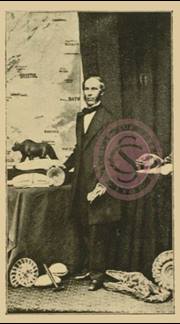|
Charles Moore was born on 8 June 1815 in Ilminster, Somersetshire, to John and Sophia. He was one of six children, three boys and three girls, one of whom drew some of the illustrations found in Moore’s publications. He was educated at the Commercial School in Ilminster until he was 12, when he moved to the free grammar school.
After his schooling he joined the family printing and bookselling business which eventually took him, at the age of 22, to Bath, to work at Mary Meyler & Son, the bookshop and publishers of the Bath Herald. The death of his father in 1844 brought about a return to Ilminster and the family business, which he ran with his eldest sister.
Moore's interest in geology started at a young age, for as a child he spent much of his school holidays collecting and polishing ammonites, which he found in abundance in his local Ilminster area. Sadly his childhood hobby was soon forgotten and replaced with study and work.
This dormant interest was rekindled somewhat during his time in Bath with occasional hikes through quarries, but it was an incident in Ilminster which secured geology as a passion of his. An old schoolhouse in Ilminster was being renovated and two boys found a pebble in the rubble to play with. The boys rolled the stone back and forth only to find it break in half. At the centre of the nodule was a perfectly preserved fossil fish which became Moore's first Liassic specimen.
|
|
 Portrait of Moore c. 1860s Portrait of Moore c. 1860s [GSL/POR/56/95]
|
|
It was in Ilminster that Moore acquired a significant
part of his palaeontological collection from the Liassic strata. It was
also at this time that Moore began making contacts amongst many
influential geologists and the value of his burgeoning fossil collection
became known to the wider community.
Moore returned to Bath in 1853, where he met and married Eliza Deare.
An advantageous marriage for Moore, it was owing to this that he was
able to give up business and pursue his geological interests with
fervour.
During this time, his scientifically most active period, he was
elected a Fellow of the Geological Society (1853), was a founder member
of the Bath Natural History and Antiquarian Field Club (1855), was
elected a member of the British Association (1859), and set up his fossil
collection at the Bath Royal Literary and Scientific Institution as a
free museum.
In the years that Moore dedicated to geology he wrote
over thirty papers and contributions to various journals, and presented
his findings in talks and lectures. Even ill health in his 60s did
not deter him from pursuing his passion and continuing his work in
geology. Much of the correspondence found in the archive collection is attributed to Moore’s later years and, as such, he is often updating his friends and colleagues on the state of his health.
Moore published his final paper shortly before his death in December 1881.
|